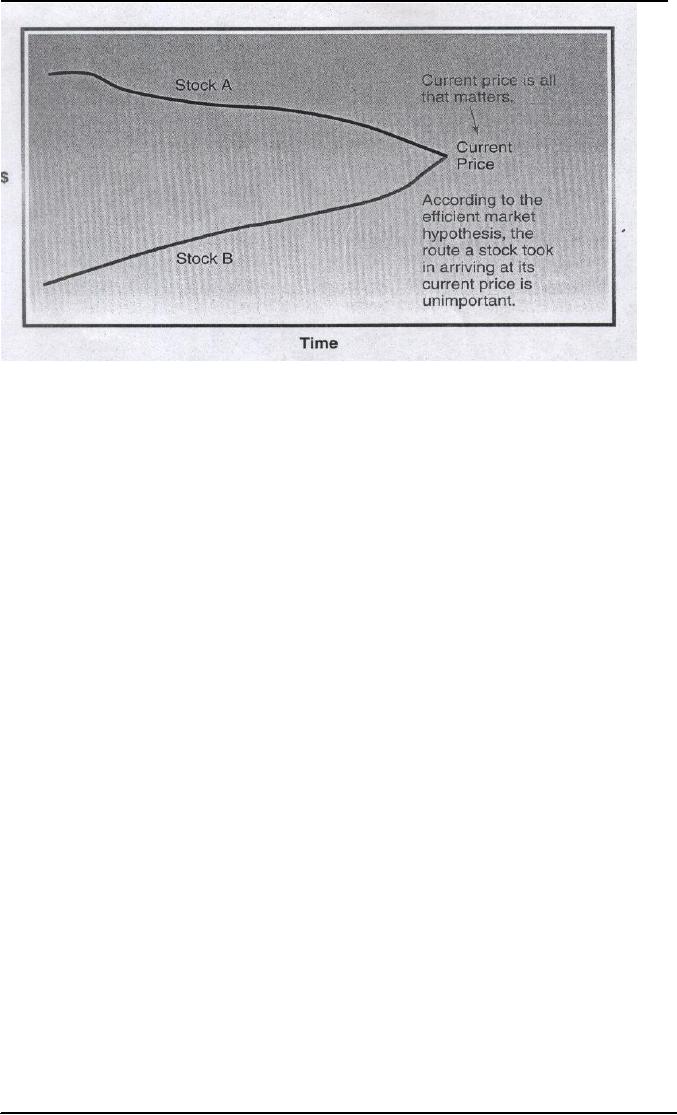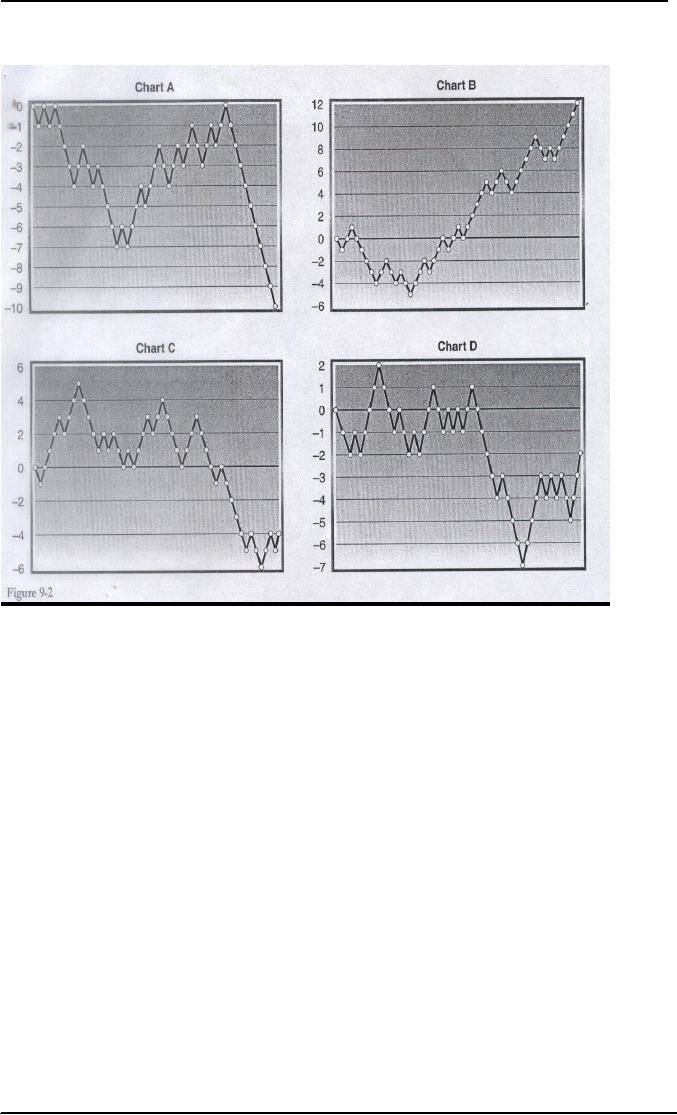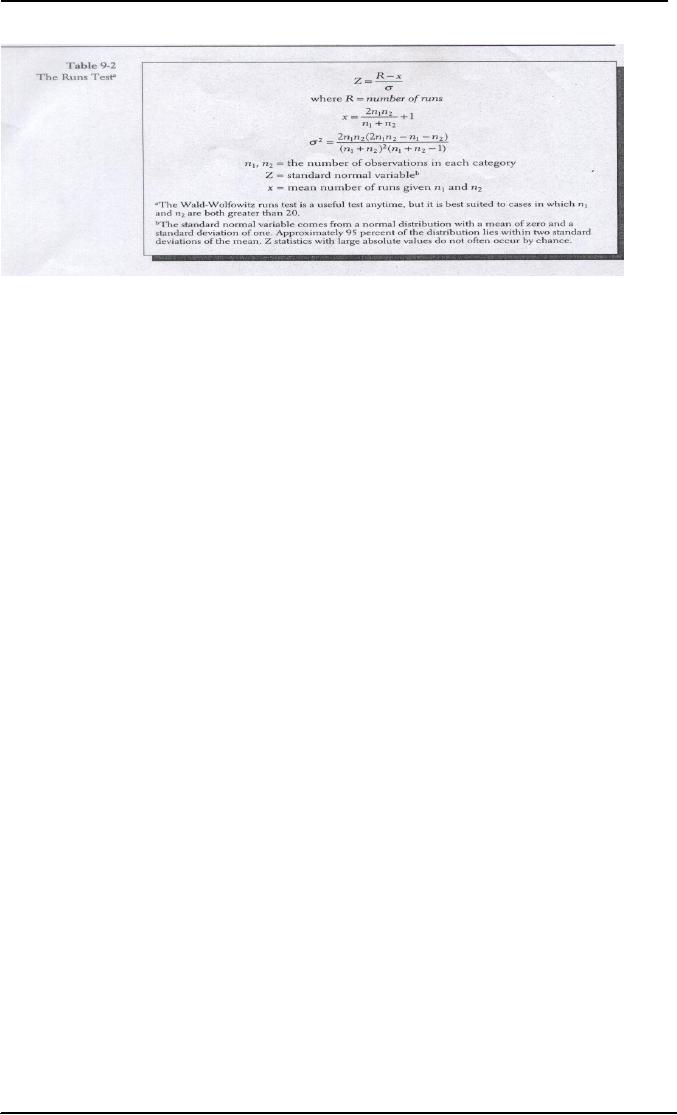 |
THE EFFICIENT MARKET HYPOTHESIS (EMH) |
| << COMMON STOCK: ANALYSIS AND STRATEGY |
| Behavioral Finance >> |

Investment
Analysis & Portfolio Management
(FIN630)
VU
Lesson
# 23
MARKET
EFFICIENCY
The
fair price function of the
capital markets provides
assurance that investors can
sell stock
at
the going price and not be
taken to the cleaners. A discussion of
fair pricing
inevitably
leads
to the efficient market
hypothesis (EMH), the theory
supporting the nation that
market
prices
are in fact fair. The EMH is
probably the single most
important paradigm in
finance.
Like
technical analysis, market
efficiency is a controversial part of
finance. In an efficient
market
security prices are based on
the available information so as to
offer and expected
return
consistent with their level
of risk. While most professors
are convinced that
the
markets
are quite efficient and that
free lunches are as scarce
as Ty Cobb baseball cards,
some
professional money managers
believe otherwise. Capital
market prices are presumed
to be
fair because they are
the equilibrium result of
the analyses of many people, each
of
whom
is seeking to increase personal wealth.
When a listed stock is put
up for sale,
hundreds
of people can bid for it.
The markets ensure that the
seller trades with the
highest
bidder.
Conversely, a buyer is confronted
with numerous potential
sellers, and the
system
ensures
that the buyer's order is
matched up with the best
price, which from the
buyer's
perspective
is the lowest price. The
greater the number of participants and
the more formal
the
marketplace, the more an
investor is assured of a good (fair)
price.
THE
EFFICIENT MARKET HYPOTHESIS
(EMH):
To
speak intelligently about
the efficient market
hypothesis a person must under-stand
what
the
hypothesis says and what it
does not say. Efficiency can
be categorized by both type
and
degree.
Types
of Efficiency:
The
two types of efficiency are
operational efficiency and informational
efficiency.
Operational
efficiency is a measure of how
well things function in
terms of speed of
execution
and accuracy. At a stock exchange,
operational efficiency is measured by
such
factors
as the number of orders lost or
filled incorrectly and the
elapsed time between
the
receipt
of an order and its execution. All
market participants are
concerned with these
matters,
but the EMH does not
refer to this type of
efficiency.
Informational
efficiency is a measure of how
quickly and accurately the
market1 reacts to
new
information. New data
constantly enter the
marketplace via economic
reports, company
announcements,
political statements, or public opinion
surveys, to name a few sources.
What
does all this information
mean? Is raising unemployment in
the United Kingdom
good
or
bad for holders of U.S.
Treasury bonds? How about a
company's announcement that
it
intends
to split its stock five
for one? Suppose the
price of gold jumps $10 an
ounce in one
day,
what effect, if any, is this
event likely to have on
stock prices?
We
know security prices adjust
rapidly and accurately to the
news without the need
to
digest it
very long. Sometimes the
speed of adjustment is remarkably
fast. For instance,
the
author
was once sitting in a brokerage firm
punching up his current
stock on the Quotron
machine.
One of his holding was
common stock in MGM Grand
Hotel. The stock was
trading
at $10�. At that very
moment, across the room,
the bell rang and the red
light
flashed
on the Dow Jones News
Service monitor, indicating
hot news. The headline
read,
"Fire
at the MGM Grand Hotel". In
the seconds it took the
author to walk from the
service
142

Investment
Analysis & Portfolio Management
(FIN630)
VU
monitor
back to the Quotron machine,
the stock fell to $7�,
which is approximately
where
it
remained the rest of the
day.
One
need not be a Mensa member
to realize that a hotel fire
is bad news. In an
informationally
efficient market, prices are
going to react fast, just as
they did in the MGM
situation.
An investor cannot expected to read
about the fire in The
Wall Street journal
the
following
day and think, "Well, I'll bet
that hammers the stock; I'd
better sell," and
then
expect
to find that the market is
still trying to sort out
the news. Prices would
have dropped
long
ago.
Because
the market is efficient, the
meaning of the news is
discovered quickly, and prices
adjust.
Students in an investments course are
sometimes disappointed to learn that
simply
taking
a stock market course does
not ordain them with
the power to read the
financial
pages
and fluently pick stocks that will
double in price by next
week. Things do not
work
that
way.
Still,
the market is not completely
efficient. It still rewards people
who process the
news
better
than the next person. For
one thing, not everyone has
access to the same news,
nor
does
everyone receive the news in
a timely fashion. Because of
this discrepancy,
market
participants
commonly talk about three
forms of the EMH, each of
which is based on the
availability
of a different level of
information.
The
efficient market hypothesis is one of
the most important paradigms in
finance.
The
efficient market hypothesis
deals with informational
efficiency, which is a measure
of
how
quickly and accurately the
market digests new
information. It is well established
that
the
market is informationally
efficient.
Degrees
of Informational Efficiency:
1.
Weak form
Efficiency:
The
least restrictive form of the EMH is
weak form efficiency, which
states that future
stock
prices
cannot be predicted by analyzing
price from the past. In
other words, charts are of
no
use
in predicting future prices.
According
to the weak form of the
EMH, how a stock arrived at
its current price is
irrelevant.
It could have followed the
route of Stock A, or it could
have behaved like
Stock
B.
The only thing that
matters is the current
price. Any information contained in
the past
price
series is already included in
the current price.
The
realization is a difficult pill
for most people to swallow. A
survey of a variety of people
would
reveal that virtually
everyone would identify
stock B as clearly a better
buy than
stock
A. After all, B is "rising"
while A is "falling". Who
would want to buy a
declining
stock?
143

Investment
Analysis & Portfolio Management
(FIN630)
VU
The
point that is missed in this
logic was made earlier: past
prices do not matter; future
ones
do.
Everyone has access to past
price information2.
According to the EMH, so
many people
are
looking at these same
numbers that any "free
lunches" have already been
consumed.
The
current price is a fair one
that takes into account
any information contained in
the past
price
data.
Human
nature is prone to extrapolate
the past into the
future. Business Week conducted
a
poll3 in late 1999 asking investors
their views on the stock
market. Fifty-eight
percent
indicated
they believed the stock
market was "very" or "somewhat"
overpriced, but 52
percent
of the respondents believed that stocks
would be higher a year
later. Respondents
aged
18 to 24 were most bullish,
with 63 percent predicting
the market would be higher
in
2000.
Oddly, though, 67 percent of
this same group predicted a
market crash in the
coming
year.
Charting
is a topic discussed in hundreds of
books. In the same way we
look for identifiable
forms
in the clouds or in star constellations,
our brains are creative
enough to find
patterns
in a
sequence of stock prices. Technical
analysts learn "important"
patterns through
folklore
or
their own
imagination.
Look
at the four graphs in Figure
9-2. Are these random
patterns, or is one or more of
them
revealing
something? Some technical
analysts would look at Chart
A and see a stock
that
has
been unsuccessful in penetrating a
"resistance level" at 0. Its failure to
rise above this
point
after several attempts is
followed by a major downturn in
the stock price.
Chart
B shows a pattern that looks
appealing. This stock is on a sustained
rise. Chart C
shows
a bearish situation. Here a stock
has penetrated its support
level at 0, resulting in a
significant
decline to the -5 area. A
technical analyst would call
this a breakout on
the
downside.
Chard D shows congestion in
the -2 to +1 range, followed by a sharp break to
a
new
equilibrium level around
-4.
What
do these patterns mean?
Would an investor be more
inclined to buy one of
these
stocks
than the others? Is one clearly
inferior to the others? Actually,
each of these figures
was
created using the random
number generating function of
Lotus 1-2-3. These are
four
successive
Lotus graph; each graph
has a different seed number
to start its series. In all
four
graph,
each observation is either one
unit greater than the
previous observation or one
unit
144

Investment
Analysis & Portfolio Management
(FIN630)
VU
smaller,
and each of the two possible
out-comes had a 50 percent probability of
occurring.
Are
these graphs useful in predicting
what Lotus will select next?
Probably not.
Past
prices do not matter; future
ones do. Weak form
efficiency
145

Investment
Analysis & Portfolio Management
(FIN630)
VU
Table
9-2 shows the procedures for
the test.
146

Investment
Analysis & Portfolio Management
(FIN630)
VU
when
they rise x percent from a subsequent
low. Because anyone can
calculate these
realized
percentages, filter rules
should not work if the
markets are weak form
efficient.
Fama
also investigated the performance of
filter rules, as have
numerous other
researchers.
The
results are similar to those of
the autocorrelation tests. Occasionally
one reads reports
of
successful filters, but they
still prove uneconomic when
the effect of transaction
costs is
included.
The
evidence against predictive chart
patterns and valuable filter
rules is so powerful
that
anything
new about this topic
seldom appears in the
finance literature. People
who review
articles
for the various academic
journals have seen
overwhelming evidence that
the market
is
weak form efficient, and
editors rarely want to
devote space to another
article confirming
decades
of prior work in this
area.
2.
Semi-strong Form:
The
weak form of the EMH states
that security prices fully reflect
any information
contained
in the past series of stock
prices. Semi-strong form efficiency
takes the
information
set s step further and
includes all publicly
available information. The
semi-
strong
form of the EMH states that
security prices fully reflect all
relevant publicly
available
information.
A
plethora of information holds
potential interest to investors. In
addition to past
stock
prices,
economic reports, brokerage firm
recommendations, investment advisory
letters, and
so on
all contain a myriad of
details about what affects
business performance and
stock
value.
While no one sees every one of
these items, the market
does, and prices move as
people make
decisions to buy and sell based on
what they learn from
the information set
available
to them.
The
news item about the MGM
Grand Hotel fire was not
past price data, but it was
publicly
available
and the stock did decline
because of it. According to
the semi-strong form of
the
EMH,
this behavior is exactly
what is expected.
Semi-strong
form efficiency states that
security prices reflect all
publicly available
information.
Tests
of Semi-strong Form
Efficiency:
Extensive
academic research supports
the semi-strong version of
the efficient market
hypothesis.
The literature devotes much
more attention to tests of
semi-strong form
efficiency
than to weak form tests. Studies
have investigated the extent
to which people can
profit
by acting on various corporate
announcements such as stock
splits, cash
dividends,
and
stock dividends. While and
occasional research paper
shows that small profits
could
have
been made in a particular
case, the general result is
consistent: The market
reacts to
public
information efficiency, and investors
will seldom outperform the
market averages by
analyzing
public news, especially if
they must pay commissions to
buy and sell.
We
recognize that the market is
pretty efficient. We have
seen time after time
that when we
get
the word that a Wall Street
firm is now recommending a
stock that stock is already
up a
point-and-a-half.
The market is that
efficient. As soon as anyone gets
wind of a firm's
recommendation-boom-people
are buying it, and that
stock's price goes up. By
then, the
value
[of the information] is
diminished.
147

Investment
Analysis & Portfolio Management
(FIN630)
VU
-Michael
J. C. Roth
Executive
Vice President
USAA
Investment Management
In
fact, academic evidence
indicates that active
portfolio managers (those
who frequently
change
their portfolios to include
"better" stocks) tend to
subtract value rather than
add it.
Most
people try to beat the Standard &
Poor's Stock Index by
picking better stocks or
moving
to better sectors of the
market. But studies show it is a
game that
underperforms.
-Leonard
H. Wissner
Chief
Investment Officer
Ward
& Winsser Capital
Management
Researchers
at The Wall Street Journal, in
conjunction with Zack's
Investment Research,
report
that for the 5-year
period ending 30 September 1999
the stock recommendations
of
only
3 of the 15 major brokerage firms
managed to outperform the
205.6 percent earned
by
the
S&P 500 index.7
In the
first nine months of 1998,
88 percent of the actively
managed
U.S.
mutual funds trailed the
performance of the S&P 500.
Most people would expect
that if
anyone
could analyze the market
better than average, the
well-trained, experienced analysts
at
the major investment houses
could. These "experts" did
not do well during this
period.
Their
substandard performance is discouraging
but surprisingly
common.
One
particularly famous study by
Ball and Brown deals with
the market's reaction
to
corporate
earnings announcements.8 This research reported
that stock prices react
favorably
to
better-than-expected earnings, and vice
versa. However, they also reported
that security
prices
seemed to anticipate the
news as much as a year prior
to the announcement, and
that
by
the time the actual
earnings were made public
and investor has little
opportunity to
capitalize
on the news.
Another
noteworthy event study
looked at the market
reaction to the death of a
corporate
chief
executive officer. Interestingly,
market prices declined when
the CEO was a
professional
manager. But when the CEO
was the company founder, the
death was
associated
with an increase in the
stock price. This finding
may mean the market
was
encouraged
about the prospect of a new
"professional" company leader.
Many
investors view stock splits
favorably, as mentioned earlier in
the book. Companies
announce
splits in advance of the actual
split date. Can investors earn
abnormal profits by
buying
shares that are about to
split? Fama is also associated
with the classic study on
this
topic.
The study found several
things. First, companies usually
increase their
dividends
when
they split their shares. If
the firm fails to do so,
the market reacts adversely
to this
preceding
the split, but once the
split is announced they
cease to accrue any further.
To
profit
from the split, investors
would have had to have
bought the shares months in
advance
of
the split date. Once
the split is announced, the
free lunch is gone.
Many
tests of semi-strong form
efficiency use the event
study methodology. In an
event
study,
a phenomenon occurring at a known
point in time, such as a
stock split or the
announcement
of corporate earnings, is designated as
time zero. Two days prior to
the event
is
day "T minus two," while
two days after would be "T
plus two." In the typical
conduct of
an
event study, a researcher
would gather a sample of firms
showing one or more instances
of
the event of interest.
Security returns before and
after the event would be
collected.
Depending
on the researcher's hypothesis, the
data might be collected for
monthly, weekly,
148

Investment
Analysis & Portfolio Management
(FIN630)
VU
daily,
or even intraday returns
how far before the
event and how long after
would also
depend
on the particular study.
Typically, the length of the
before and after periods is
the
same.
Regardless
of the month or year in
which the event occurred,
each stream of returns is
then
"lined
up" so that each company's
event corresponds to day zero.
For instance, the
first
observation
might be a split that
occurred on March 4, 1988.
The second company
might
have
had a split on August 15,
1992. Both of these dates
would be time zero in the
event
study.
In both instances the following
day would be day T plus
one.
3. Strong
Form Efficiency:
The
most extreme version of the
EMH is strong form efficiency.
This version states
that
security
prices fully reflect all public and
private information. In other
words, even
corporate
insiders cannot make abnormal
profits by exploiting their
private; inside
information
about their company. Inside
information is formally called
material, nonpublic
information.
Section
16 of the Securities Exchange
Act of 1934 defines an insider as
"an officer or
director
of a public company, or an individual or
entity owning 10 percent or
more of any
class
of a company's shares." The law
requires insiders to report
their holdings of
corporate
securities
within 10 days of becoming an insider.
They must also report
subsequent
transactions
in these securities for
themselves or a member of their
family by the tenth
day
of
the month following the
trade.
The
evidence does not support
this form of the EMH.
Insiders can make a profit on
their
knowledge,
and every year people go to jail, get
fined, or get suspended from
trading for
doing
so. Inside information gives
an unfair advantage that can be used to
extract millions
of
dollars out of the
marketplace. Where did these
millions in profit come from?
They came
from
the pockets of individual investor
who did not have
access to the
confidential
corporate
news. Society does not
feel this advantage is fair;
consequently, insider trading
is
illegal.
The
Enforcement Division of the
Securities and Exchange Commission is
responsible for
detecting
and prosecuting insider trading
violations. People sometimes believe
they can stay
at
arm's length from the
law by passing the inside
information to a relative, who
passes it to
a
friend, who passes it to
someone else who then
acts upon it to the benefit
of all parties
concerned.
This strategy seldom works
unless the trades are
small. (Investigating
small
potential
violations is not economically
feasible). All brokerage accounts are
computerized,
and it is a
relatively simple matter to
screen for unusual account
activity surrounding
mergers,
important corporate announcements, and
similar events.
The
Insider Trading Sanctions
Act of 1984 permits the
courts to impose civil penalties of
up
to
three times the profit
gained or loss avoided because of the
use of material,
nonpublic
information,
plus it provides for a
criminal fine of up to $100,000. It also
precludes
corporate
officers, directors, and anyone
owning 10 percent or more of a
firm's equity
securities
from making a profit on a purchase and
sale of the company's equity
within a six-
month
period. These people also may not
sell the company's equity
short.
The
Insider Trading and Securities
Fraud Enforcement Act of 1988 is
related legislation.14 It
increased
criminal fines to $1 million,
raised the maximum jail
term to ten years,
and
required
firms involved in the
securities business to implement
programs to prevent
insider
trading
by their employees. The real
teeth of the law comes
from holding a firm liable
if its
149

Investment
Analysis & Portfolio Management
(FIN630)
VU
employees
engage in insider trading, and
providing a 10 percent bounty to
encourage
informants
to come forward.
The
strong form of EMH states
that security prices fully reflect
all relevant public
and
private
information.
Tests
of Strong Form Efficiency:
Strong
form tests are more
difficult to conduct because it
would be hard to do so
without
breaking
the law. We can, however,
find evidence to support the
potential value of
inside
information.
Business
Week publishes a column
called "Inside Wall Street,"
in some respects similar
to
The
Wall Street Journal's "Heard on
the Street" column. Stock
prices often react to news in
these
types of articles, but they
should not react until the
publication hits the streets.
The
magazine
is not released to the
public until 5:15 PM on
Thursdays, so news of stocks
mentioned
in the "Inside Wall Street"
column in not public
information during the
Thursday
trading
day.
Unusual
trading activity in a number of stocks
mentioned in the column over
a period of
five
months led McGraw-Hill; the
publisher of Business Week, to inform
officials at the
Securities
and Exchange Commission as well as at
the exchange.15 Table 9-4 shows
the
suspicious
price movement.
For
seven issues of the magazine
over this period, stocks
mentioned in the article
rose an
average
of 11.54 percent compared to an average
rise of 0.12 percent in the Standard
&
Poor's
500 stock index. The large
Thursday rise and increased trading
volume was
compelling
evidence that someone was
trading ahead of the public
distribution of the
magazine.
This act was illegal trading on
inside information.
The
Semi-Efficient Market
Hypothesis:
The
essence of the semi-efficient
market hypothesis (SEMH), a
cousin to the EMH, is
the
notion
that some stocks are priced
more efficiently than
others. This idea is
appealing to
many
market analysts. Consider
two very different companies
such as IBM and a
hypothetical
start-up firm called
Triple-Scan Video. Everyone
has heard of international
Business
Machines, which trades on
the New York Stock
Exchange and many
regional
exchanges.
Thousands of portfolios contain
its shares, and virtually
all security analysts
watch
it. The likelihood of
realizing an unusual gain in
the shares of IBM is
extremely
small.
The stock is priced fairly,
and investors who buy some
will likely earn a long-term
return
consistent with the stock's
level of risk.
What
about Triple-Scan Video?
According to the SEMH, fewer
people are watching
this
company,
which implies a greater likelihood
these shares will be undervalued. In
other
words,
the stock might not be
priced as efficiently as the
shares of IBM or other
well-known
companies.
This
idea is sometimes used in support of
the thesis that the market
has several tiers.
The
first
tier contains IBM, GM, Exxon, and
other large firms. The
second tier might
contain
lesser-known
but well-established companies such as
those that trade on the
American
Stock
Exchange or the NASDAQ
National Market System. The
third tier might be
companies
such as Triple-Scan Video.
Another tier might be pink
sheet stocks. The
further
down
the tier list an investor
goes, the less efficient
the pricing, or so the
reasoning goes.
150

Investment
Analysis & Portfolio Management
(FIN630)
VU
It is
probably safe to say that
most students of the market
are generally sympathetic to
the
logic
of the semi-efficient market
hypothesis. It is not possible to follow
every security.
Analysts
need to follow the big
names, and simply do not
have time to research the
ever-
expanding
list of emerging companies.
The
essence of the semi-efficient
market hypothesis is the
notion that some stocks
are
priced
more efficiently that
others.
Security
Prices and Random
Walks:
The
efficient market hypothesis
states that the current
stock price fully reflects
relevant
news
information. While some of
the news is expected, much of it is
unexpected. The
unexpected
portion of the news, by
definition, arrives randomly
the essence of the
notion
that
security prices follow a random
walk because of the random
nature of the news.
Some
days
the news is good, some days
it is bad. Specifics of the
news cannot be predicted
with
great
accuracy.
Substantial
uncertainty even surrounds
news that seems reasonably
predictable. An article
in
Forbes reported the result
of a study showing that over
the period 1973-1990, the
average
error
made by security analysts in
forecasting the next
quarter's corporate earnings
for the
firms
they covered was 40 percent. On an
annual basis, the average
error was never less
than
25
percent. From 1985 to 1990,
the average error was 52
percent, indicating that
the
analysts'
forecasting ability had not
improved over the
period.
It is
perfectly possible for analysts to
disagree in an efficient market. As an
example, on
November
30, 1998, the firm
Van Kasper and Company reaffirmed
its "Strong Buy"
recommendation
on Transocean Offshore (RIG,
NYSE). That same day
Janney
Montgomery
Scott changed its recommendation
from "Moderate Buy" to
"Strong Sell."
When
the news relevant to a
particular stock is good, people
adjust their estimates of
future
returns
upwards or they reduce the
discount rate they attach to
these returns. Either way
the
stock
price goes up. Conversely,
when the news is bad,
the stock price goes
down.
Many
people misunderstand what the
random walk idea really
means. It does not say
that
stock
prices move randomly. Rather, it
says that the unexpected
portion of the news
arrives
randomly,
and that stock prices adjust to
the news, whatever it
is.
In a
famous analogy, a drunk
staggers from lamppost to
lamppost with a point of
departure
and a
target destination. The path
of the drunk shows a trend
from one post to the
next.
Along
the way, however, the
path is erratic. The drunk
wanders right and left,
perhaps
occasionally
out into the street or into
a building wall. The precise
route cannot be
predicted.
The same is true of a
security price and its
consequent return. Over the
long run,
security
returns are consistent with
what we expect, given their
level of risk. In the
short
run,
however, many ups and downs
seem to cloud the long-run
outlook. The stock
price
behaviors
shown in the four charts of
Figure 9-2 are random
walks. Each succeeding
observation
is just as likely to be up as
down.
ANOMALIES:
This
section reviews several
important market anomalies
that financial researchers
actively
explore.
In finance, the term anomaly
refers to unexplained results
that deviate from
those
expected
under finance theory,
especially those related to the
efficient market
hypothesis.
Familiar
anomalies include the low PE
effect, the small firm
effect, the neglected
firm
effect,
the January effect, and the
overreaction effect.
151

Investment
Analysis & Portfolio Management
(FIN630)
VU
The
Low PE Effect:
Numerous
academic studies have uncovered
evidence that stocks with
low PEs provides
higher
returns than stocks with
higher PEs. This tendency is
called the low PE effect.
The
studies
show this result even
after accounting for risk
differentials, which seems to be
in
direct
conflict with the capital
asset pricing model and the
theory behind it.
Some
evidence indicates that low PE
stocks outperform higher PE
stocks of similar
risk.
Low-Priced
Stock:
Many
people believe that certain
stock price levels are
either too high or too
low.
Equivalently,
they believe the price of
every stock has an optimum
trading range. By
finance
theory, the stock price
should be merely a marker
and, by itself, be of no value
in
comparing
firms. The size (and value)
of a piece of pie depends on the
number of pieces
into
which the pie is cut.
Still,
folklore surrounds stock prices. As
early as 1936, the academic
literature showed
that
low-priced
common stock tended to earn higher
returns as stock with a high
price. 18
In
the
classic
investment book by Graham and
Dodd, the authors state, "It is a
commonplace of the
market
that an issue will rise more
steadily from 10 to 40 than
from 100 to 400."
Consider
the following question: Is it
easier for a stock to rise
from $5 to $6 than it is for
it
to rise
from $50 to $60? Most people
who play the market
believe it is. If it is the
case
(which
theory and empirical evidence
dispute), then every firm
whose stock sold for
$50
should
split ten for one so that
its share price would
advance faster.
The
Small Firm and Neglected
Firm Effects:
Like
the low PE effect, the
small firm effect and the
neglected firm effect are
two important
market
anomalies that influence the
stock selection of some
investors (and some
portfolio
managers).
The
Small Firm
Effect:
The
small firm effect recognizes
that investing in small
firms (those with low
capitalization)
seems
to, on average; provide superior
risk-adjusted returns. Solid
financial research
supports
this hypothesis. Important
papers on this topic include
those by Reinganum20 and
by
Banz.
The
obvious implication of the
small firm effect is that
portfolio managers should
give
small
firms particular attention in
the security selection
process. We do not know why
the
small
firm effect exists, but it
seems to persist. In the past,
some anomalies tended to
disappear
soon after they were
reported. The small firm
effect is still with
us.
The
Neglected Firm
Effect:
The
neglected firm effect is a
cousin to the small firm
effect and the semi-efficient
market
hypothesis.
Institutional investors are sometimes
limited to larger capitalization
firms. As a
consequence,
security analysts do not pay
as much attention to those firms
that are unlikely
portfolio
candidates. One paper by Arbel,
Carvell, and Strebel investigated 510
firms over a
ten-year
period and found, as expected, that
the smaller firms
outperformed those widely
152

Investment
Analysis & Portfolio Management
(FIN630)
VU
22
held
by institutions. The authors
postulated that institutions
might perceive more risk
with
the
smaller firms, and hence they
ignore them. In a related
paper, Arbel and Strebel
showed
other
evidence that the attention
of security analysts does
affect the way shares
are priced,
and
that if analysts neglect a
firm it has a systematic
impact on the share
value.
The
implication is the same as
with the small firm
effect: Neglected firms seem
to offer
superior
returns with surprising
regularity. When the Arbel,
Carvell, and Strebel paper
was
published
in 1983, the authors closed by
stating that the effect was
"unlikely to persist over
time."
Neglected firms continue to be an
important research area that
we have not yet
figured
out.
Market
Overreaction:
Another
area of current research
interest lies in the observed
tendency for the market
to
overreact
to extreme news, with the
general result that
systematic price reversals
can
sometimes be
predicted. For instance, if stocks
fall dramatically, they have
a tendency to
perform
better than their betas
indicate they should in the
following period. De Bondt
and
Thaler
have written several
important papers dealing
with this subject.
Experimental
psychologists know that people
often rely too heavily on
recent data at the
expense
of the more extensive set of
prior data. At a race track,
for instance the
betting
pattern
on the following race, even
if the handicapper was largely inaccurate
on previous
races.
In their studies, De Bondt and Thaler
found "systematic price
reversals for stocks
that
experience
extreme long-term gains or losses:
Past losers significantly outperform
past
winners."
Brown
and Harlow found that the
overreaction is stronger to bad
news than to good
news
during
the period of their study.
After an especially large
drop, security returns over
the
following
period were unusually large
and persistent.
The
January Effect:
Another
well-known anomaly is called
the January effect. Numerous
studies show
persuasive
evidence that stock returns
are inexplicably high in
January, and that small
firms
do
better than large firms in
January.
In
Richard Roll's Journal of
Portfolio Management study,
the begins by reporting, "For
18
consecutive
years, from 1963 through
1980, average returns of
small firms have been
larger
than
average returns of large
firms on the first trading
day of the calendar year."
Comparing
AMEX stocks,
which are generally smaller
firms, with those on the
NYSE, Roll found
that
the
average return differential was
1.16 percent in favor of the
small firms, and that the
t-
statistic
for significance of the
difference was a whopping
8.18.
Several
explanations of this phenomenon
have been proposed. Branch
proposes that the
superior
January performance comes
from tax loss trading late
in December.27 A better
explanation
is probably provided by Rogalski and
Tinic, who provide evidence
that the risk
of
small stocks is not constant
over the year, and tends to be
especially high early in
the
year.
The reason for this
higher risk phenomenon is
itself unexplained. Kiem
explains this
result
by reporting another anomaly.
For some reason, stocks tend to trade
near the bid price
at
the end of the year and
toward the ask price at
the beginning of the year.
In any event,
January
tends to be a good month for the
stock market.
Some
analysts will argue that this
effect should really be
called the "November
through
January"
effect because these three
months stand out for their
good performance. Time
153

Investment
Analysis & Portfolio Management
(FIN630)
VU
30
magazine
recently reported on a study by
the Hirsch Organization that
shows since 1950
the
S&P 500 index was up an average 1.7
percent in November, 1.8
percent in December,
and
another 1.7 percent in
January. The next best
month was April at 1.4
percent.
(September is
the only month that is
negative, down 0.2 percent
on average.)
Other
studies find evidence of a January
effect in securities other
than common stock.
Chen
documents
the presence of the effect
with high, medium and
speculative grades of
preferred
stock.31 Wilson and Jones do so for
corporate bonds and commercial
paper.32
Gay and
Kim
look
at seasonality in the futures
markets.34
The
January effect is a pervasive
result that
puzzles
many people.
Further,
some people consider the
first five trading days of
January to be a harbinger of
how
stocks will
perform for the rest of the
year. Since 1950 in only three years
(1966, 1973 and
1990)
has the S&P 500 been
higher at the end of the
first week of the year,
but lower by the
end of
the year. Some people refer
to this as the January
indicator to distinguish it from
the
January
effect. It is probably not an
especially useful indicator.
The market is usually up
for
the
year, and the historical
data indicate a bad first
week for the S&P 500
does not predict a
down
year for the
market.
Stock
returns are inexplicably
high in January, and small
firms' stocks do better than
large
firms'
in this month.
The
Weekend Effect:
The
weekend effect is the observed
phenomenon that security
price changes tend to
be
negative
on Mondays and positive on the
other days of the week, with
Friday being the
best
of
all.35 This persistent
result does not yet
have a satisfactory explanation.
Some
behaviorists
claim that people are upbeat on
Fridays, and this attitude
translates into stock
market
optimism. Monday is a down
day in other ways, so it
might as well be a down
day
for
the market, too, or so the
thinking goes. Whatever the
cause, the weekend effect
remains
as
anomaly. Once again,
however, the effect is too
small to be economically
significant.
The
Persistence of Technical
Analysis:
Market
efficiency tests, especially those
dealing with the weak
form; have routinely
found
that
any evidence of market
inefficiency cannot be profitably
exploited after including
the
effects
of transaction costs. Still, an immense
amount of literature is printed
each year based
in
varying degrees on technical
techniques that, if the EMH is
true, should be
useless.
Even
finance professors seem less
than totally committed to
the EMH paradigm. In a
national
survey pf investment professionals, 40
percent of the respondents with a
Ph. D. in
finance
felt that advance-decline
lines (a popular technical
analysis tool) were "useful"
or
"very
useful." One-fourth of the respondents
agreed that "charts enhance
investment
performance."
Needless
to say, we do not fully understand
the theory or practice of
technical analysis.
Its
techniques
are generally imprecise and do
not lend themselves to
rigorous statistical
testing.
Certain
phenomena from the clinical
psychology literature seem to be at least
partially
operative
in the stock market. At a casino
craps table, for instance,
shooters throw the dice
harder
when trying for a high
number. Low numbers, of course,
require an easier toss.
Even
though
no connection can be made between
the random number that
occurs and the
strength
of
the toss, the shooters
experience a psychological illusion of
control. Similarly,
humans
suffer
from hindsight bias. With
trading techniques, people tend to
remember their
154

Investment
Analysis & Portfolio Management
(FIN630)
VU
successes
and displace their failures. One
investor, for example, owned
200 shares of a
common
stock, his only investment.
On days when the stock was up a
point, he would brag,
"I
made $200 today." On days when
the stock was down, he said
nothing. Later, when
the
stock
rose a point again, in his
view he "made another $200."
He made that same
$200
many
times.
Final
Thoughts:
The
U.S capital markets are
informationally and operationally quite
efficient from the
individual
investor's perspective. They
are the envy of much of
the world, and many
developing
second and third world
cultures emulate them.
Portfolio managers, however,
are
hired
and fired largely on the
basis of realized return, and a
few basis points can make
a
significant
difference in the progression of
their careers. Inefficiencies
that may be
economically
insignificant to a retail customer
after considering trading
fees may be much
more
attractive to an institutional
investor.
Eugene
Fama and Kenneth French
recently reported updated research on
the nature of asset
pricing
that may eventually be
helpful in explaining market
anomalies. Expanding on
their
earlier
work, they find "anomalies
largely disappear in a three-factor
model," where
security
prices
are determined by the excess
return on the market
portfolio, the difference
between
the
returns on portfolio of small stocks and
a portfolio of large stocks, and finally
the
difference
between the returns on a
portfolio of high book-to-market stocks
and low book-
to-market
stocks. Importantly, though, they state,
"The three-factor risk-return
relation is,
however,
just a model. It surely does
not explain expected returns on
all securities and
portfolio."
In
sum, much is not yet
known about asset pricing.
The markets are not
perfect. Still, the
vast
number of securities traded on the
exchanges, the rapid introduction of
new financial
products,
and the globalization of world economies
provide a fair, but
complicated financial
battleground.
Summary:
The
efficient market hypothesis
(EMH) relates to informational efficiency
and the fair
pricing
function as opposed to operational
efficiency. The essence of
the EMH is that so
many
people watch the marketplace
that few if any individuals
can consistently make
windfall
profits by picking stocks better
than the next person.
There
are three forms of the
EMH. The weak form
says that past prices, or
charts, are of no
value
in predicting future stock
price performance. The
semi-strong form says that
security
prices
already fully reflect all
relevant publicly available
information. The strong form
of
the
EMH includes private, inside
information as well. Considerable
empirical research
supports
the semi-strong form;
however, we know that
insiders can make illegal
profits.
The
random walk theory does
not state that security
prices move randomly. Rather
it
maintains
that the news arrives
randomly, and that in accordance
with the EMH security
prices
rapidly adjust to this
random arrival of
news.
Anomalies
are occurrences in the
market that are inexplicable
by finance theory. Stocks
with
low PEs tend to show
unusually higher returns;
January is a good month for
the stock
market;
and small firms tend to do
especially well in January.
Technical analysis is
diametrically
opposed to the efficient
market hypothesis, yet it
has many advocates,
including
well-educated finance professors and
practitioners.
155
Table of Contents:
- INTRODUCTION OF INVESTMENT
- THE ROLE OF THE CAPITAL MARKETS
- THE NASDAQ STOCK MARKET
- Blue Chip Stocks, Income Stock, Cyclical Stocks, Defensive Stocks
- MARKET MECHANICS
- FUNDAMENTAL STOCK ANALYSIS
- BEYOND FUNDAMENTAL ANALYSIS
- What is Technical Analysis
- Indicators with Economic Justification
- Dow Theory
- VALUATION PHILOSOPHIES
- Ratio Analysis
- INVESTMENT RATIOS
- Bottom-Up, Top-Down Approach to Fundamental Analysis
- The Industry Life Cycle
- COMPANY ANALYSIS
- Analyzing a Company’s Profitability
- Objective of Financial Statements
- RESEARCH PHILOSPHY
- What Is An Investment Company
- Exchange-Traded Funds (ETFs)
- COMMON STOCK: ANALYSIS AND STRATEGY
- THE EFFICIENT MARKET HYPOTHESIS (EMH)
- Behavioral Finance
- MARKET INDEXES
- POPULAR INDEXES
- BOND PRINCIPLES
- BOND PRICING AND RETURNS
- Accrued Interest
- BOND RISKS
- UNDERSTANDING RISK AND RETURN
- TYPES & SOURCES OF RISK
- Measuring Risk
- ANALYZING PORTFOLIO RISK
- Building a Portfolio Using Markowitz Principles
- Capital Market Theory: Assumptions, The Separation Theorem
- Risk-Free Asset, Estimating the SML
- Formulate an Appropriate Investment Policy
- EVALUATION OF INVESTMENT PERFORMANCE
- THE ROLE OF DERIVATIVE ASSETS
- THE FUTURES MARKET
- Using Futures Contracts: Hedgers
- Financial Futures: Short Hedges, Long Hedges
- Risk Management, Risk Transfer, Financial Leverage
- OVERVIEW